Detroit, Michigan
 From Nwe
From Nwe | Detroit | |||

|
|||
|
|||
| Nickname: The Motor City, Motown, Renaissance City, The D, Hockeytown, The Automotive Capital of the World, Rock City, The 313 | |||
| Motto: Speramus Meliora; Resurget Cineribus (Latin: We Hope For Better Things; It Shall Rise From the Ashes) |
|||
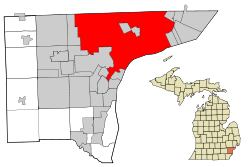
|
|||
| Coordinates: 42°19′N 83°02′W | |||
|---|---|---|---|
| Country | |||
| State | |||
| County | Wayne | ||
| Founded | 1701 | ||
| Incorporated | 1806 | ||
| Government | |||
| - Type | Mayor-Council | ||
| - Mayor | Mike Duggan (D) | ||
| Area | |||
| - City | 143.0 sq mi (370.4 km²) | ||
| - Land | 138.8 sq mi (359.5 km²) | ||
| - Water | 4.2 sq mi (10.9 km²) | ||
| - Urban | 1,295 sq mi (3,354 km²) | ||
| - Metro | 3,913 sq mi (10,134.6 km²) | ||
| Elevation [1] | 600 ft (183 m) | ||
| Population (2020)[2] | |||
| - City | 639,111 | ||
| - Density | 4,606.87/sq mi (1,778.72/km²) | ||
| - Metro | 4,392,041 (14th) | ||
| Time zone | EST (UTC−5) | ||
| - Summer (DST) | EDT (UTC−4) | ||
| Area code(s) | 313 | ||
| FIPS code | 26-22000GR2 | ||
| GNIS feature ID | 1617959[1] | ||
| Major airport | Detroit Metropolitan Wayne County Airport (DTW) | ||
| Website: DetroitMI.gov | |||
Detroit is the largest city in the U.S. state of Michigan and the seat of Wayne County. It is located in southeastern Michigan on the Detroit River opposite the city of Windsor, Ontario, Canada. The Detroit River connects Lake Erie and Lake St. Clair, contributing to the city's important role as a major port city.
"Detroit" is a word almost universally associated with the American automotive industry. The city is also an important contributor of popular music legacies, celebrated by the city's two familiar nicknames, Motor City and Motown.
The city was once the fourth largest in the United States, but since 1950 it experienced a major shift in population to the suburbs. The name Detroit is commonly used to refer to the Metro Detroit area, a sprawling region with a population of 4,467,592. The Detroit-Windsor area, a critical commercial link straddling the Canadian U.S. border, has a total population of nearly 5,700,000. The city is home to roughly 50 percent of the state's population.
As part of an effort to revive its economy, Detroit began offering casino gaming, the largest city in the United States to do so. Detroit now ranks as the fifth largest gambling market in the United States. Though the casinos brought new tax revenue and jobs to the city, unemployment remained high.
Geography
Topography

According to the United States Census Bureau, the city has a total area of 143.0 square miles (370.2 km²). The highest elevation is in northwestern Detroit, at a height of 670 feet (204 m). Detroit's lowest elevation is along its riverfront, at a height of 579 feet (176 m). Detroit completely encircles the cities of Hamtramck and Highland Park. On its northeast border are the wealthy communities of Grosse Pointe. The Detroit River International Wildlife Refuge is the only international wildlife preserve in North America, uniquely located in the heart of a major metropolitan area. The refuge includes islands, coastal wetlands, marshes, shoals, and waterfront lands along 48 miles (77 km) of the Detroit River and western Lake Erie shoreline.
Detroit and the rest of southeastern Michigan have a continental climate that is influenced by the Great Lakes. Winters are cold with moderate snowfall, while summers are warm with temperatures sometimes exceeding 90 °F (32 °C). Average monthly precipitation ranges from about two to four inches (50 to 100 mm). Snowfall, which typically occurs from November to early April, ranges from 1 to 10 inches (3 to 25 cm) per month.
Cityscape
The Detroit International Riverfront includes a partially completed 3.5-mile riverfront promenade with a combination of parks, residential buildings, and commercial areas. The riverfront includes Tri-Centennial State Park and Harbor, Michigan's first urban state park. The second phase is a 2-mile (3 km) extension to the Ambassador Bridge for a total of 5 miles (8 km) of parkway. Civic planners envision that the riverfront properties condemned under eminent domain, with their pedestrian parks, will spur more residential development.
Neighborhoods

The Midtown and the New Center areas are centered around Wayne State University and Henry Ford Hospital. Midtown has about 50,000 residents, yet it attracts millions of visitors each year to its museums and cultural centers; for example, the Detroit Festival of the Arts draws about 350,000 people. The University Commons-Palmer Park district in northwest Detroit is near the University of Detroit Mercy and Marygrove College and has historic neighborhoods including Palmer Woods, Sherwood Forest, and Green Acres.
History


Cass Ave. at Amsterdam St.


The city name comes from the Detroit River (French: l'étroit du Lac Érié), meaning the strait of Lake Erie, linking Lake Huron and Lake Erie. Traveling up the Detroit River, Father Louis Hennepin noted that the north bank of the river was an ideal location for a settlement. In 1701, Antoine de la Mothe Cadillac, along with 51 additional French-Canadians, founded a settlement. France offered free land to attract families to Detroit, which grew to 800 people in 1765, the largest city between Montreal and New Orleans. The French surrendered the fort in 1760 to the British during the French and Indian War.
Several tribes led by Chief Pontiac, an Ottawa leader, launched Pontiac's Rebellion (1763), including a siege of Fort Detroit. Partially in response to this, the British Royal Proclamation of 1763 included restrictions on white settlement in unceded Indian territories.
Detroit passed to the United States under the Jay Treaty (1796). In 1805, a fire destroyed most of the settlement.
From 1805 to 1847, the rebuilt Detroit was the capital of Michigan. Detroit fell to British troops during the War of 1812, was recaptured by the United States in 1813, and incorporated as a city in 1815.
Prior to the Civil War, the city's access to the Canadian border made it a key stop along the underground railroad. Many Detroiters volunteered to fight during the Civil War, beginning with the Iron Brigade that defended Washington, D.C., early in the war.
During the late 1800s and early 1900s, many of the city's Gilded Age mansions and buildings arose. Detroit was referred to as the Paris of the West for its architecture, and for Washington Boulevard, recently electrified by Thomas Edison. Strategically located along the Great Lakes waterway, Detroit emerged as a transportation hub. The city had grown steadily from the 1830s with the rise of shipping, shipbuilding, and manufacturing industries.
In 1896, a thriving carriage trade prompted Henry Ford to build his first automobile in a rented workshop on Mack Avenue. In 1904 he founded the Ford Motor Company. Ford's manufacturing—and those of automotive pioneers William C. Durant, the Dodge brothers, Packard, and Walter Chrysler—reinforced Detroit's status as the world's automotive capital; it also served to encourage truck manufacturers such as Rapid and Grabowsky.
With the introduction of Prohibition, smugglers used the river as a major conduit for Canadian spirits, organized in large part by the notorious Purple Gang.
Strained racial relations were evident in the 1920s trial of Dr. Ossian Sweet, a black Detroit physician acquitted of murder. A man died when shots were fired from Ossian's house into a threatening mob of whites who gathered to try to force him out of an all-white neighborhood.
Labor strife climaxed in the 1930s when the United Auto Workers became involved in bitter disputes with Detroit's auto manufacturers. The labor activism of those years brought notoriety to union leaders such as Jimmy Hoffa and Walter Reuther.
Industrial growth during World War II led to Detroit gaining the nickname the Arsenal of Democracy. Industry spurred spectacular growth during the first half of the twentieth century as the city drew tens of thousands of new residents, particularly workers from the South, to became the nation's fourth largest. At the same time, tens of thousands of European immigrants poured into the city. Social tensions rose with the rapid pace of growth. The color blind promotion policies of the auto plants resulted in racial tension that erupted into a full-scale riot in 1943.
Consolidation during the 1950s, especially in the automobile sector, increased competition for jobs. An extensive freeway system constructed in the 1950s and 1960s facilitated commuting. The Twelfth Street riot in 1967, as well as court-ordered busing to end racial segregation accelerated white flight from the city.
Commensurate with the shift of population and jobs to its suburbs, the city's tax base eroded. In the years following, Detroit's population fell from a peak of roughly 1.8 million in 1950 to about half that number by the end of the century.
The gasoline crises of 1973 and 1979 impacted the U.S. auto industry as small cars from foreign makers made inroads. Heroin and crack cocaine use afflicted the city. Renaissance has been a perennial buzzword among city leaders, reinforced by the construction of the Renaissance Center in the late 1970s. This complex of skyscrapers, designed as a city within a city, slowed, but was unable to reverse, the trend of businesses leaving the city's downtown until the 1990s.
In 1980, Detroit hosted the Republican National Convention, which nominated Ronald Reagan to a successful bid for president. By then, nearly three decades of crime, drug addiction, and inadequate policies had caused whole areas to decay. During the 1980s, abandoned structures were demolished to reduce havens for drug dealers, with sizable tracts of land reverted to a form of urban prairie.
In the 1990s, the city began to enjoy a revival, much of it centered downtown. Comerica Tower at Detroit Center (1993) arose on the city skyline. In the ensuing years, under new leadership, three casinos opened in Detroit: MGM Grand Detroit and MotorCity Casino, which now have permanent resorts, and Greektown Casino, which is scheduled to open its permanent resort at the end of 2009.
The city's riverfront is the focus of much development. In 2007, the first portions of the Detroit River Walk were laid, including miles of parks and fountains. This new urban development in Detroit is a mainstay in the city's desire to reinvent its economic identity through tourism. Along the river, upscale million-dollar condominiums are going up, some of the most expensive the city has ever seen.
Law and government
The city government is run by a mayor and nine-member city council and clerk elected on an at-large nonpartisan ballot. Since 1974, Detroit has had a "strong mayoral" system, with the mayor approving departmental appointments. The council approves budgets but the mayor is not obligated to adhere to any earmarking. City ordinances and substantially large contracts must be approved by the council. The city clerk supervises elections and is formally charged with the maintenance of municipal records. Municipal elections for mayor, city council and city clerk are held at four-year intervals, in the year after presidential elections.
Detroit's courts are state-administered and elections are nonpartisan. The city is home to the Thirty-Sixth District Court, as well as the First District of the Michigan Court of Appeals and the United States District Court for the Eastern District of Michigan.
Politics

Politically, the city consistently supports the Democratic Party in state and national elections.
Urban development in Detroit has been an important issue. In 1973, the city elected its first black mayor, Coleman Young. Despite development efforts, his combative style during his five terms in office was not well received by many whites. Mayor Dennis Archer (in office 1994 - 2001), a former Michigan Supreme Court Justice, refocused the city's attention on redevelopment with a plan to permit three casinos downtown.
Crime
Although crime in Detroit has declined in recent decades, the city has continued to have a high rate of violent crimes. This incidence of crime in parts of the city has brought it notoriety. The city has tried to shake its crime-laden image for the city center, where crime has been shown to be much lower than national, state, and metropolitan averages.[3] As with many border cities, there is an ongoing problem with smuggling, including drugs, human trafficking, and illicit commerce aimed at avoiding taxation.
Economy

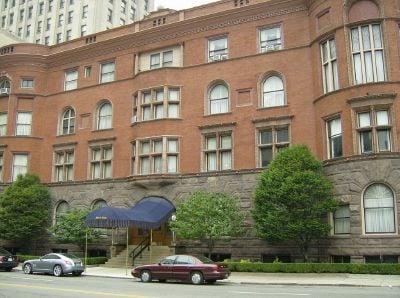
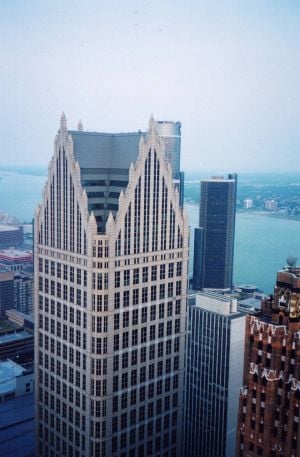


Detroit and the surrounding region constitute a major manufacturing center, most notably as home to the Big Three automobile companies, General Motors, Ford, and Chrysler. There are about four thousand factories in the area, many of which are related to the auto industry. The city is an important center for global trade with large international law firms having their offices in both Detroit and Windsor. About 80,500 people work in downtown Detroit, comprising 21 percent of the city's employment. The area is also an important source of engineering job opportunities.
The Detroit area is accustomed to the economic cycles of the auto industry. A rise in automated manufacturing using robot technology, inexpensive labor in other parts of the world, and increased competition have led to a steady transformation of certain types of manufacturing jobs in the region. Local complications for the city include higher taxes than the nearby suburbs, with many unable to afford the levies on property.
Unemployment and poverty
In the city, the unemployment rate was 14.2 percent at the end of 2005, leaving Detroit with more than one-third of its residents below the poverty line. This is in part attributed to white-flight following court-ordered busing to end racial segregation in the schools during the 1970s. Parts of the city have abandoned and burned-out shells of buildings. Though the city has struggled with finances, since 2006 it has balanced its budget, with more funding available to demolish blighted properties.
Auto industry
Despite foreign competition for market share, Detroit's automakers continued to gain volume with the expansion of the American and global automotive markets. In the late 1990s, Detroit's automakers were enjoying record profits until the recession of 2001 caused a severe decline in the stock market along with a pension and benefit funds crisis.
With rising oil prices in 2007–2008, consumers chose to purchase fewer trucks and sport-utility vehicles. Widespread layoffs, a credit crunch, and loss of consumer confidence in the U.S. economy in 2008 also contributed to plummeting profits for Detroit's Big Three automakers.
Emerging technologies
Firms in the suburbs are pursuing emerging technologies including biotechnology, nanotechnology, information technology, cognotechnology, and hydrogen fuel cell development. The city of Detroit has made efforts to lure the region's growth companies downtown with advantages such as a wireless Internet zone, business tax incentives, entertainment, an international riverfront, and residential high rises, with some success. In 2007, Quicken Loans announced its development agreement with the city to move its world headquarters, and 4,000 employees, to downtown Detroit.
Some Fortune 500 companies headquartered in Detroit include General Motors, auto parts maker American Axle & Manufacturing, and DTE Energy. Detroit is home to Compuware and the national pizza chain Little Caesars. Downtown Detroit has major offices for Electronic Data Systems, Visteon, Delphi, Ford Motor Company, PricewaterhouseCoopers, Ernst & Young, Deloitte Touche, KPMG, the Jeep and Dodge Truck arm of Chrysler, GMAC, and OnStar. Other major industries include advertising, law, finance, chemicals, and computer software. One of the nation's largest law firms, Miller, Canfield, Paddock & Stone P.L.C., has offices in both Windsor and Detroit. Compuware's new headquarters, GM's move to the Renaissance Center, and Michigan's redevelopment of Cadillac Place in the New Center district have provided new synergies for the redevelopment of downtown.
Medical service providers such as the Detroit Medical Center and Henry Ford Hospital are also major employers in the city.
Casinos
Casino gaming plays an important economic role, with Detroit the largest city in the United States to offer casino resorts. Caesars Windsor, Canada's largest, complements the MGM Grand Detroit, MotorCity Casino, and Greektown Casino in Detroit. Though the casinos have brought new tax revenue and jobs to the city, the city still has high unemployment.
Transportation

With its proximity to Canada and its facilities, ports, major highways, rail connections, and international airports, Detroit is an important transportation hub. The city has three international border crossings, the Ambassador Bridge, Detroit-Windsor Tunnel, and Michigan Central Railway Tunnel, linking Detroit to Windsor, Ontario. The Ambassador Bridge is the single busiest border crossing in North America. Detroit Metropolitan Wayne County Airport (DTW), the area's principal airport, is located in nearby Romulus.
The city is at the crossroads for three Interstate highways. Construction and completion of a third border crossing would eliminate (or greatly diminish) the traffic jams that plague the Ambassador Bridge and the Detroit-Windsor Tunnel.
Demographics
At its peak, Detroit was the fourth largest in the country, but since 1950 the city has seen a major shift in its population to the suburbs. Metro Detroit suburbs are among the more affluent in the United States, in contrast to lower incomes found within the city limits.
The city's population increased more than sixfold during the first half of the twentieth century, fed largely by an influx of Eastern European, Lebanese, and Southern migrants to work in the burgeoning automobile industry. Since 1950, however, the city has seen a major shift in its population to the suburbs. The city's population dropped from its peak in 1950 of 1,849,568 to 916,952 in 2007. This is partly attributable to the construction of an extensive freeway system making commuting easier during the 1950s, and white flight.
The Detroit suburbs in Oakland County, Macomb County, and northeastern and northwestern Wayne County are predominantly white. Of the African-Americans who live in the metropolitan area, about 70 percent live within the Detroit city limits.
Metro Detroit's ethnic communities are diverse and include descendants of the French founders, as well as Irish, Germans, Scots, Poles, Italians, Greeks, Serbians, Turks, Armenians, Jews, Arabs, and Lebanese who settled during the city's early twentieth-century industrial boom. Metro Detroit has the largest concentration of Belgians outside Belgium. Nearby Dearborn has a sizable concentration of Arab Americans.
Education


The Detroit Public Schools (DPS) district is the largest school district in Michigan and consists of 220 schools. The city is also served by various charter schools and private schools, as well as parochial Roman Catholic schools run by the Archdiocese of Detroit.
Detroit is home to several institutions of higher learning, including Wayne State University, a national research university with medical and law schools in the Midtown area. Other institutions in the city include the Detroit College of Law, now affiliated with Michigan State University.
Culture
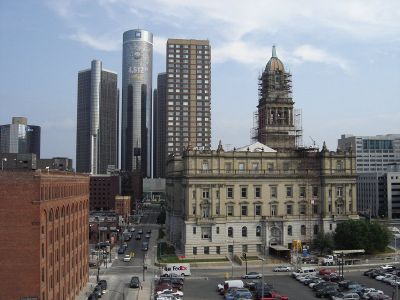


Entertainment and performing arts
Live music has been a prominent feature of Detroit's nightlife since the late 1940s, bringing the city recognition under the nickname Motown. The metropolitan area has two nationally prominent live music venues: DTE Energy Music Theatre and the Palace of Auburn Hills. The Detroit Theater District is the nation's second largest. Major theaters include the Detroit Opera House and Orchestra Hall, which hosts the renowned Detroit Symphony Orchestra.
The city of Detroit has contributed to a number of different genres over the decades leading into the new millennium. In the 1940s, blues artist John Lee Hooker became a long-term resident, bringing the Mississippi Delta Blues to northern cities like Detroit. During the 1950s, the city became a center for jazz.
Berry Gordy, Jr. founded Motown Records, which rose to prominence during the 1960s and early 1970s with acts such as Stevie Wonder, The Temptations, Diana Ross and the Supremes, and Marvin Gaye. The Motown Sound played an important role in the crossover appeal with popular music, since it was the first record label owned by an African American to primarily feature African-American artists. Gordy moved Motown to Los Angeles in 1972 to pursue film production, but the company has since returned to Detroit.
Detroit's musical history includes many popular rock bands from the 1960s and 1970s. In the 1980s, Detroit was an important center of the hardcore punk rock underground, with many nationally known bands coming out of the city and its suburbs. In recent times, the city has produced a number of influential artists. The city has an active garage rock genre that has generated national attention. Detroit has also been cited as the birthplace of techno music.
Tourism
Many of the area's prominent museums are located in the historic cultural center neighborhood around Wayne State University. These museums include the Detroit Institute of Arts, the Detroit Historical Museum, Charles H. Wright Museum of African American History, and the Detroit Science Center. Important history of Detroit and the surrounding area is exhibited at the Henry Ford Museum and Greenfield Village, the nation's largest indoor-outdoor museum complex, with emphasis on American Culture. One prominent recent acquisition was the bus made famous by Rosa Parks.
Sports
Detroit is one of 13 American metropolitan areas that are home to professional teams representing the four major sports in North America. All these teams but one play within the city of Detroit itself. There are three active major sports venues within the city: Comerica Park (home of the Major League Baseball team Detroit Tigers), Ford Field (home of the NFL's Detroit Lions), and Joe Louis Arena (home of the NHL's Detroit Red Wings).
Sailboat racing is a major sport in the Detroit area. Lake St. Clair is home to many yacht clubs, which host regattas.
Looking to the future
Despite the new developments downtown, Detroit has the highest home foreclosure rate among the nation’s 100 largest metropolitan areas, with over 67,000 foreclosed properties, 65 percent of which remain vacant. Consequently, the city was awarded $47.1 million by the U.S. Department of Housing and Urban Development (HUD) as its share of the Housing and Economic Recovery Act of 2008. This legislation aimed to foster market recovery and stabilize neighborhoods.
Detroit faced several challenges even prior to this crisis, including a shrinking population, a market where the supply of housing exceeded the demand, a declining tax base, older housing stock, and an old infrastructure system. The city's goal is to focus on demolitions, with the hope that eliminating blighted structures in the nine targeted neighborhoods, for future development or alternative land uses, will have a stabilizing impact on those neighborhoods most severely impacted by foreclosure and abandonment. The city expects this process will result in reversal of the decline of housing values, significant elimination of blighted and abandoned structures, and stimulation of other investment in and around the target neighborhoods.
Gallery
-

Detroit's skyline at Hart Plaza.
-

St. Joseph Catholic Church (1873) is a notable example of Detroit's fine ecclesial architecture.
-

Penobscot Building (1928) left, with the Dime Building (1912).
-

Detroit skyline along the Detroit River.
-

A view of the city from Belle Isle Park.
-

Fox Theatre lights up 'Foxtown' in downtown Detroit
-

Comerica Park 2007
-

Looking towards Ford Field the night of Super Bowl XL
Notes
- ↑ 1.0 1.1 Feature Detail Report for: Detroit Geographic Names Information System (GNIS). Retrieved February 23, 2022.
- ↑ QuickFacts: Detroit city, Michigan United States Census Bureau. Retrieved February 23, 2022.
- ↑ Jessica Byrd, Detroit Crime: Perception vs. Reality Michigan Chronicle, May 20, 2015. Retrieved February 23, 2022.
References
ISBN links support NWE through referral fees
- Bak, Richard. Detroit Across 3 Centuries. Detroit: Thompson Gale, 2001. ISBN 1585360015
- Burton, Clarence M. Cadillac's Village: A History of the Settlement, 1701–1710. Detroit: Detroit Society for Genealogical Research, 1896. ISBN 0943112214
- Burton, Clarence M. Early Detroit: A sketch of some of the interesting affairs of the olden time. Burton Abstracts, 1912. OCLC 926958
- Chafets, Zev. Devil's Night: And Other True Tales of Detroit. New York: Random House, 1990. ISBN 0394585259
- Farley, Reynolds, et al. Detroit Divided. Russell Sage Foundation Publications, 2002. ISBN 0871542811
- Farmer, Silas. History of Detroit and Wayne County and Early Michigan. Omnigraphics, Inc. Reprint edition, 1998 (original 1889). ISBN 1558889914
- Gavrilovich, Peter and Bill McGraw. The Detroit Almanac. Detroit Free Press, 2000. ISBN 0937247340
- Hill, Eric J. and John Gallagher. AIA Detroit: The American Institute of Architects Guide to Detroit Architecture. Wayne State University Press, 2002. ISBN 0814331203
- Meyer, Katherine Mattingly and Martin C.P. McElroy with Introduction by W. Hawkins Ferry, Hon A.I.A. 1980. Detroit Architecture A.I.A. Guide, Revised Ed. Wayne State University Press. ISBN 0814316514.
- Parkman, Francis. The Conspiracy of Pontiac. University of Nebraska Press, 1994 (original 1989). ISBN 0803287372
- Poremba, David Lee. Detroit: A Motor City History. (Images of America). Arcadia Publishing, 2003. ISBN 0738524352
- Powell, Lyman Pierson. "Detroit, the Queen City." In Historic Towns of the Western States. New York: G. P. Putnam's sons, 1901. Retrieved February 23, 2022.
- Sharoff, Robert. American City: Detroit Architecture. Wayne State University Press, 2005. ISBN 0814332706
- Sobocinski, Melanie Grunow. Detroit and Rome: Building on the past. Ann Arbor: Regents of the University of Michigan, 2005. ISBN 0933691092
- Sugrue, Thomas J. The Origins of the Urban Crisis. Princeton University Press, 1998. ISBN 0691058881
- Woodford, Arthur M. This is Detroit: 1701–2001. Wayne State University Press, 2001. ISBN 0814329144
External links
All links retrieved July 26, 2022.
- City of Detroit.
- Detroit - The History and Future of the Motor City.
- Detroit Economic Club.
- Detroit Historical Society.
- The Detroit News.
- Detroit Riverfront Conservancy.
- Downtown Detroit Partnership.
- Experience Detroit.
- Guide2Detroit.
- Midtown Detroit.
Credits
New World Encyclopedia writers and editors rewrote and completed the Wikipedia article in accordance with New World Encyclopedia standards. This article abides by terms of the Creative Commons CC-by-sa 3.0 License (CC-by-sa), which may be used and disseminated with proper attribution. Credit is due under the terms of this license that can reference both the New World Encyclopedia contributors and the selfless volunteer contributors of the Wikimedia Foundation. To cite this article click here for a list of acceptable citing formats.The history of earlier contributions by wikipedians is accessible to researchers here:
- Detroit,_Michigan history
The history of this article since it was imported to New World Encyclopedia:
- History of "Detroit, Michigan"
Note: Some restrictions may apply to use of individual images which are separately licensed.
↧ Download as ZWI file | Last modified: 02/03/2023 19:26:58 | 34 views
☰ Source: https://www.newworldencyclopedia.org/entry/Detroit | License: CC BY-SA 3.0
 ZWI signed:
ZWI signed:
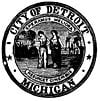
 KSF
KSF